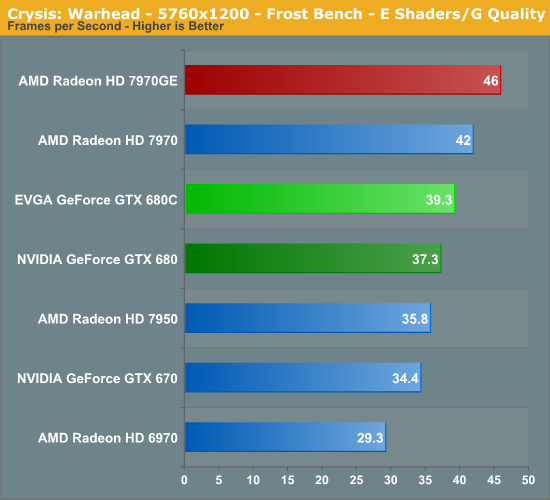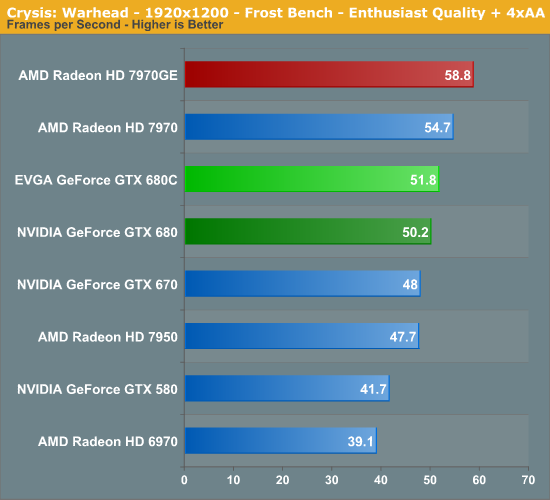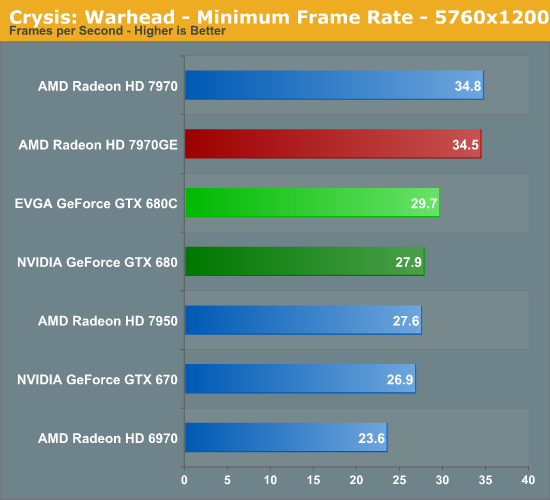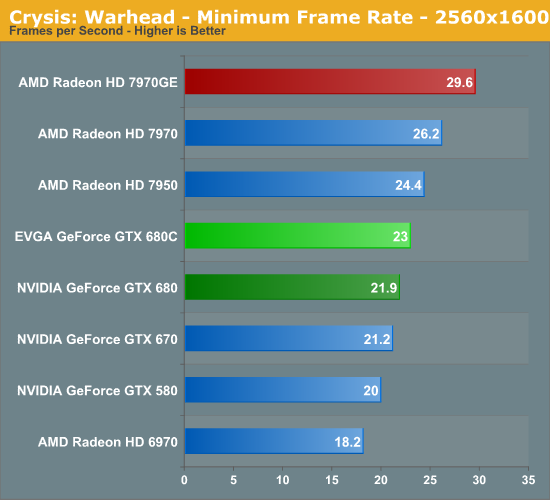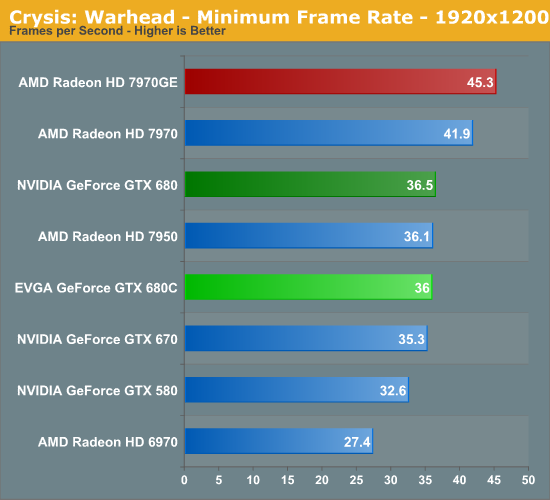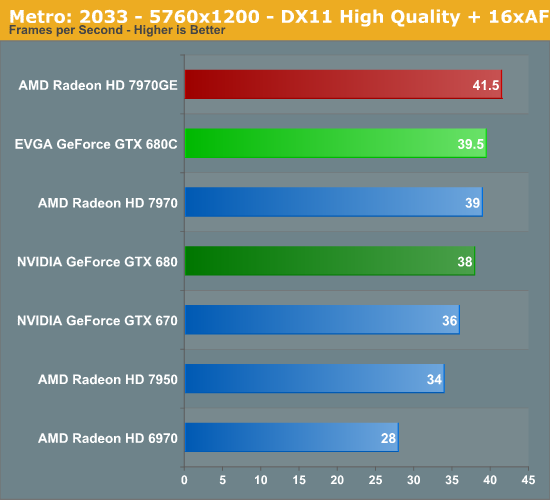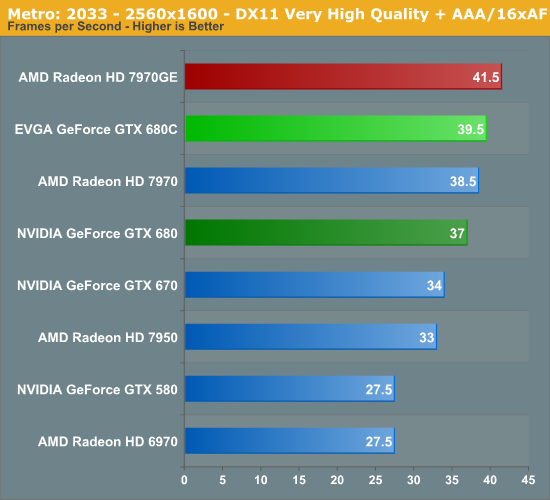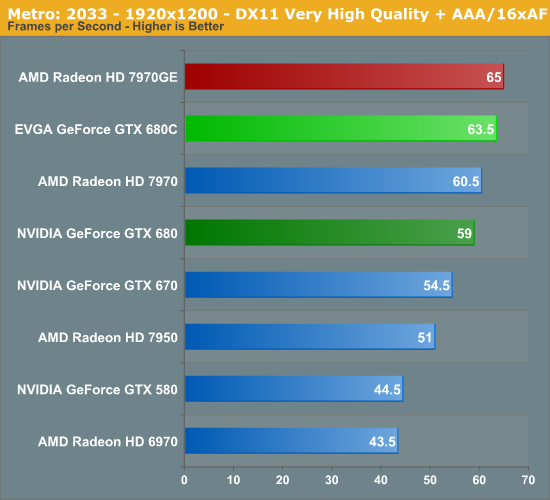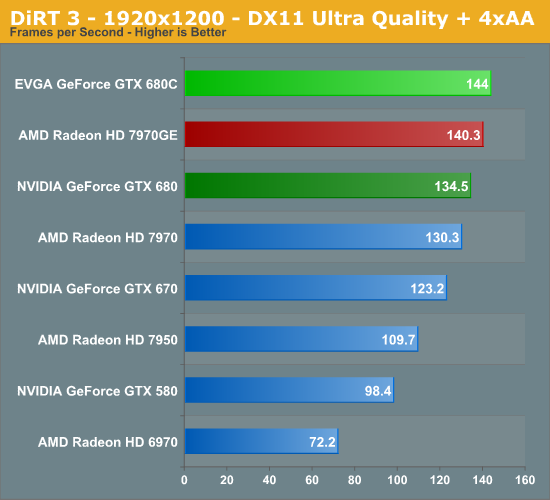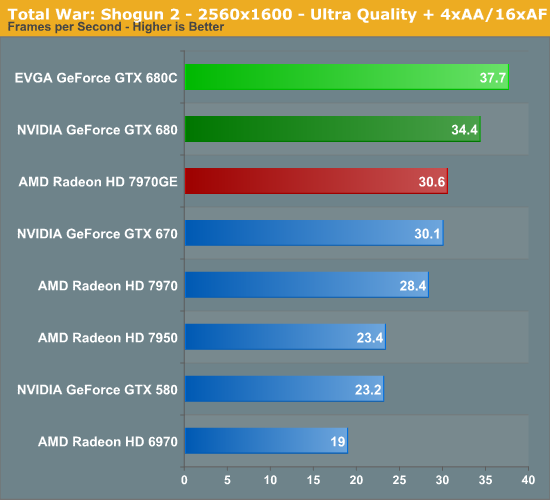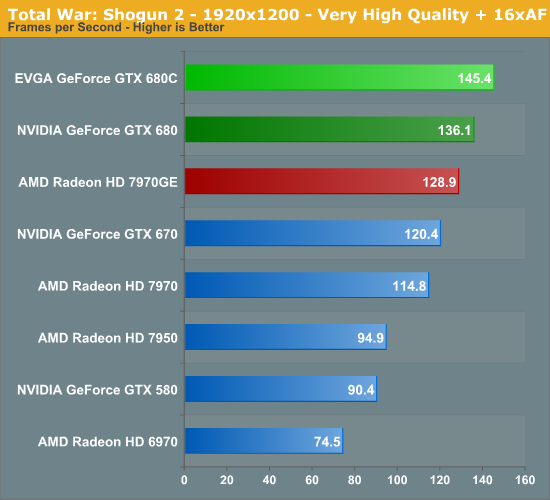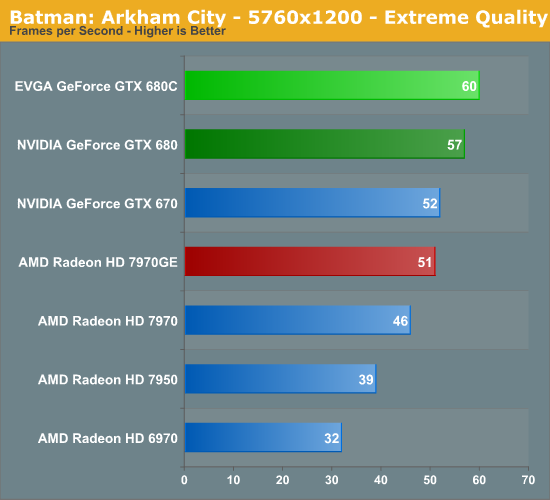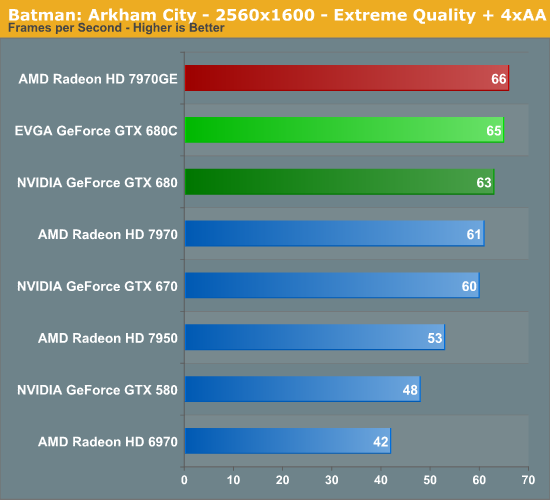A powerful graphics card is likely the most expensive component in your
PC if you're a gamer, but with all current and past-gen GPUs available in the range of $100 to $500, it can be tough to pick the right solution for your needs.
In an effort to narrow things down, we're about to compare today's most relevant gaming cards that sell for $200 or more, testing them in a slew of games to see how it breaks down as we look for the best graphics cards for gaming at resolutions of 1920x1200 and 2560x1600.
Most GPU releases go through our testbench, however when we review these graphics cards, the GPUs are fairly new or barely making it to market, drivers are not entirely optimized, and most importantly, true market pricing has not settled down to its long-term value.
| Models | Launch | Codename | Fab | Bandwidth | Release
Price | Current
Price |
| GeForce GTX 670 | 10-May-12 | GK104 | 28nm | 192.2 GB/s | $400 | $400 |
| GeForce GTX 680 | 22-Mar-12 | GK104 | 28nm | 192.2 GB/s | $500 | $500 |
| Radeon HD 7870 | 19-Mar-12 | Pitcairn XT | 28nm | 153.6 GB/s | $350 | $310 |
| Radeon HD 7850 | 19-Mar-12 | Pitcairn Pro | 28nm | 153.6 GB/s | $250 | $250 |
| Radeon HD 7950 | 31-Jan-12 | Tahiti Pro | 28nm | 240.0 GB/s | $450 | $350 |
| Radeon HD 7970 | 9-Jan-12 | Tahiti XT | 28nm | 264.0 GB/s | $550 | $450 |
| GeForce GTX 560 Ti | 25-Jan-11 | GF114 | 40nm | 128.2 GB/s | $250 | $230 |
| Radeon HD 6870 | 22-Oct-10 | Barts XT | 40nm | 134.4 GB/s | $240 | $180 |
1920x1200 Performance
 Performance: Radeon HD 7950
Value: Radeon HD 7870
Performance: Radeon HD 7950
Value: Radeon HD 7870
For an average of at least 60fps or better when playing Metro 2033 at 1920x1200, the Radeon HD 7950 is your best choice with 68fps. That said, the HD 7870 offers a better value and delivers totally playable performance at 56fps. The GTX 670 also performed well, but because
it costs more and performs slightly worse than the HD 7950, it's not the best option here.
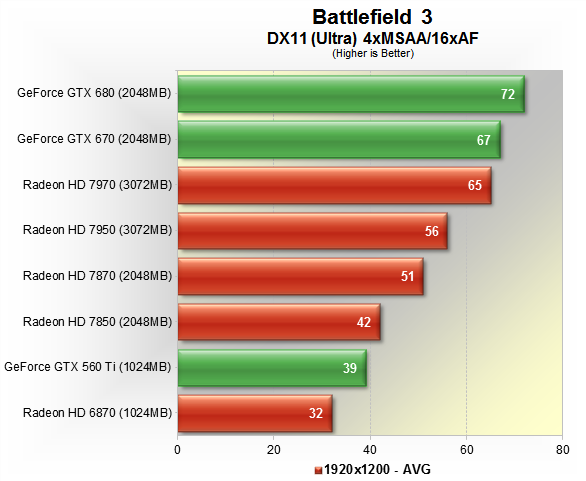 Performance: GeForce GTX 670
Value: Radeon HD 7950 or 7870
Performance: GeForce GTX 670
Value: Radeon HD 7950 or 7870
The GTX 670 managed to outpace the HD 7950 and HD 7970 by 11fps and 2fps, making it an
easy pick for the best overall pick. However, HD 7950 remains a viable value-minded solution with 56fps, as does the HD 7870, which was only 9fps below the 60fps threshold.
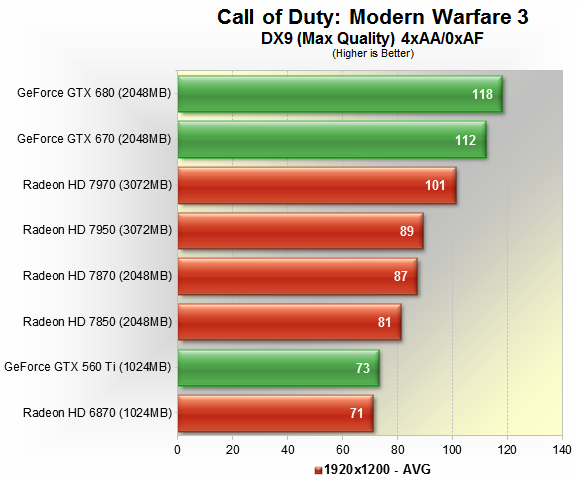 Performance: Radeon HD 7850
Value: Radeon HD 6870
Performance: Radeon HD 7850
Value: Radeon HD 6870
Call of Duty: Modern Warfare 3 -- as you likely know -- isn't particularly demanding, making the GTX 670 and HD 7000 series overkill. At 1920x1200, the HD 6870 is more than capable of delivering a smooth experience at 71fps, as is the GTX 560 Ti at 73fps.
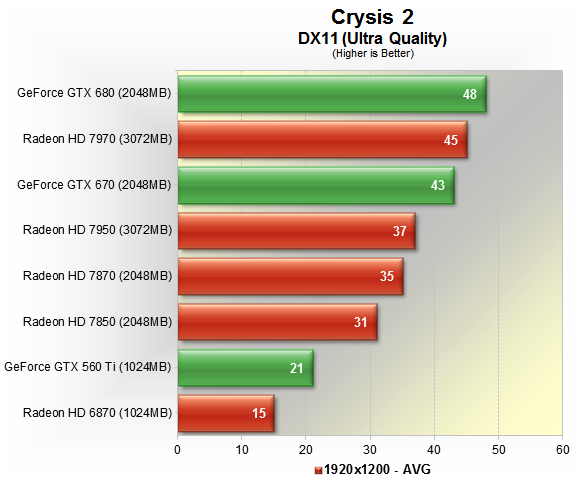 Performance: GeForce GTX 680
Value: GeForce GTX 670
Performance: GeForce GTX 680
Value: GeForce GTX 670
Crysis 2 is extremely demanding with the high-resolution texture pack and the DX11 patch, so you'll want to hit it with all the force your wallet can muster, making the GTX 680 and 670 the best
performance and value-oriented picks.
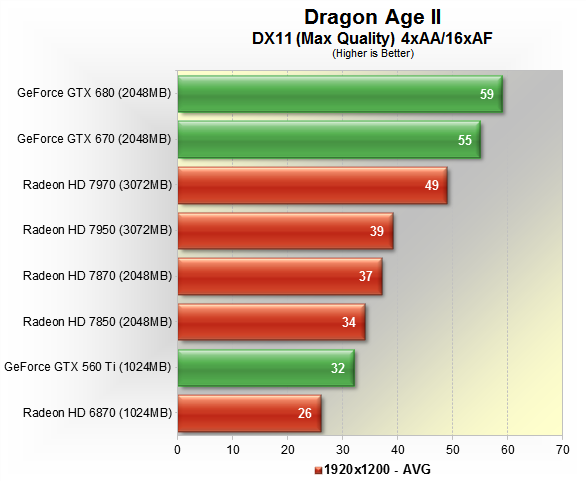
1920x1200 Performance, Part 2
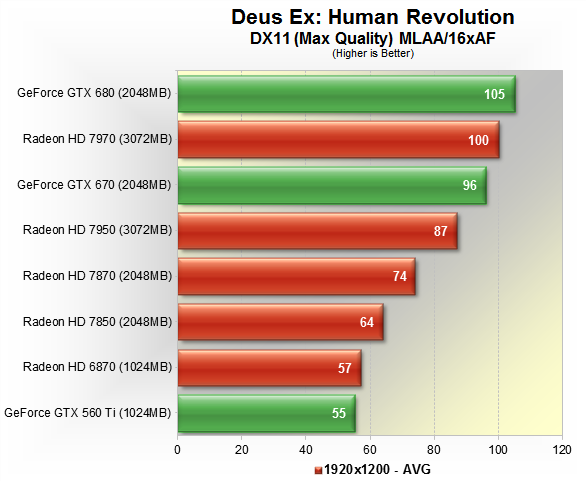 Performance: Radeon HD 7950
Value: Radeon HD 7850
Performance: Radeon HD 7950
Value: Radeon HD 7850
Despite looking great, Deus Ex: Human Revolution isn't all that demanding on current-gen cards -- in fact, even the older HD 6870 and GX 560 Ti
perform well. The best value at 1920x1200 is the HD 7850, while the best performance-oriented card is the HD 7950 at 87fps.
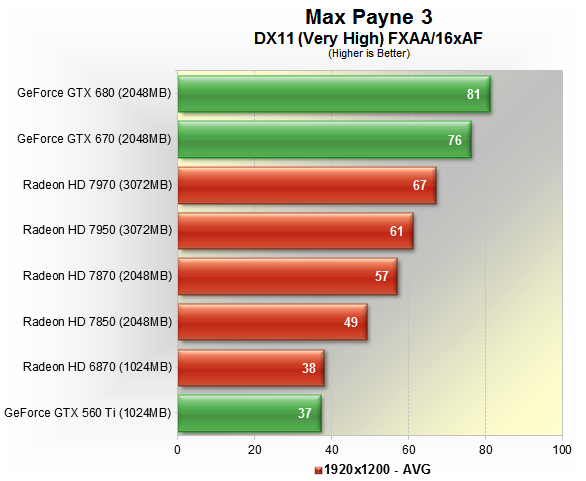 Performance: GeForce GTX 670
Value: Radeon HD 7950
Performance: GeForce GTX 670
Value: Radeon HD 7950
Max Payne 3 plays exceptionally well on the new GTX 600 series cards and we believe that the GTX 670 is the best choice if you're looking for high
performance, while the HD 7950 is the best value at 61fps, or only 6fps behind the pricier HD 7970.
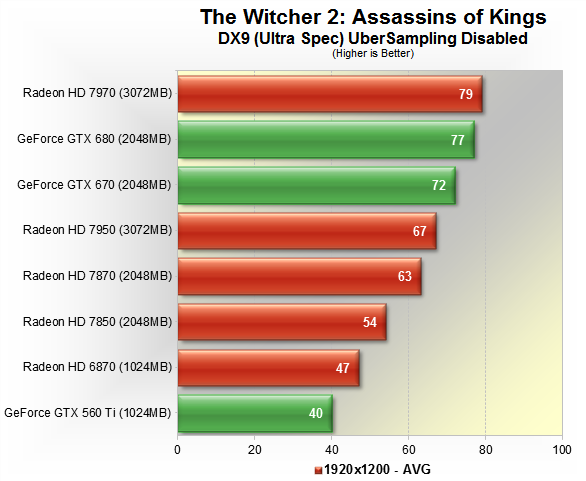 Performance: GeForce GTX 670
Value: Radeon HD 7950
Performance: GeForce GTX 670
Value: Radeon HD 7950
Although it doesn't look (or perform) like it, The Witcher 2 uses DX9, which we found hard to believe when first testing this game. The game is pretty demanding at 1920x1200, though the GTX 670 managed to deliver 72fps, securing our performance-oriented pick, while the HD 7950 was only 5fps slower at 67fps, making it our value pick.
 Performance: GeForce GTX 670
Value: Radeon HD 7870
Performance: GeForce GTX 670
Value: Radeon HD 7870
While it is also a DX9 title, Skyrim isn't as demanding as The Witcher 2, so the GTX 670 can be considered somewhat overkill at 86fps, but it's still our top pick for a performance solution, while the HD 7870 is our value choice as it was on par with the more expensive HD 7950 at 63fps.
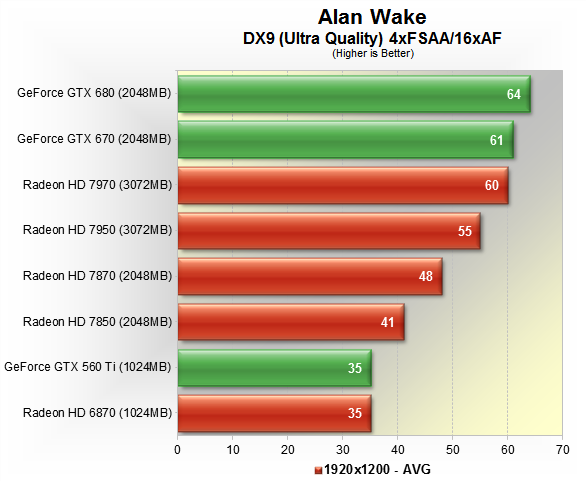 Performance: GeForce GTX 670
Value: Radeon HD 7950
Performance: GeForce GTX 670
Value: Radeon HD 7950
The GTX 670 is a clear winner when testing Alan Wake at 1920x1200, averaging 61fps, slightly
faster than the HD 7970 and just a fraction slower than the GTX 680. The best value option here is the HD 7950, which was just 10% slower than the GTX 670 while costing around 15% less.
2560x1600 Performance
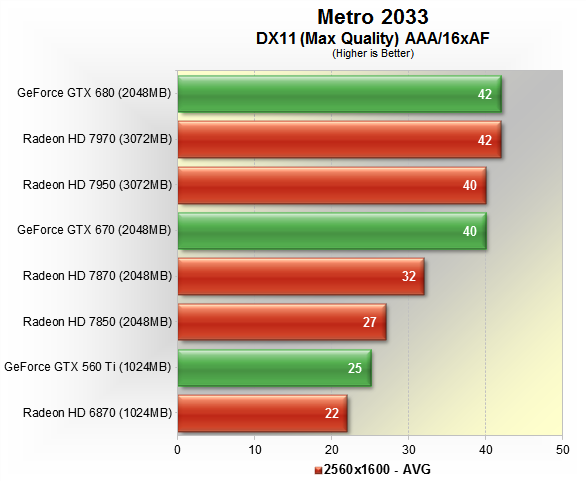 Performance: Radeon HD 7950
Value: Radeon HD 7950
Performance: Radeon HD 7950
Value: Radeon HD 7950
The HD 7950 comfortably secured our
performance slot, pumping only 2fps less than the HD 7970 and GTX 680 while costing substantially less. It also happens to be the best value solution.
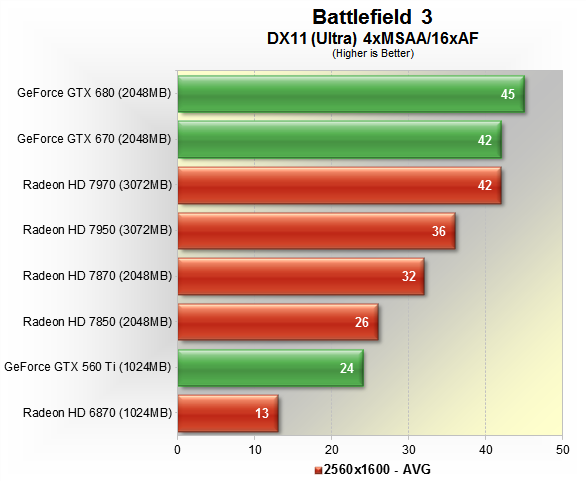 Performance: GeForce GTX 670
Value: GeForce GTX 670
Performance: GeForce GTX 670
Value: GeForce GTX 670
Battlefield 3 is quite intensive when running on maximum quality at 2560x1600, with the GTX 680 being the fastest card at only 45fps. Considering the
savings involved, the GTX 670 3fps detriment seems like a worthwhile trade, and the GTX 670 is easily the best overall value in this title.
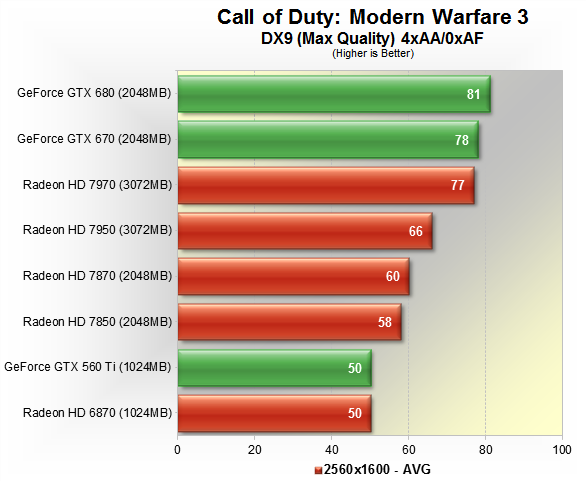 Performance: GeForce GTX 670
Value: Radeon HD 7950
Performance: GeForce GTX 670
Value: Radeon HD 7950
Modern Warfare 3 failed to utilize the power of current-gen
AMD and Nvidia GPUs, but the GTX 670 still gets our vote as the best performance card as it was just a fraction slower than the GTX 680 at 78fps. The HD 7950 shared a similar price versus performance ratio, and it's the best value option with a perfectly playable 66fps.
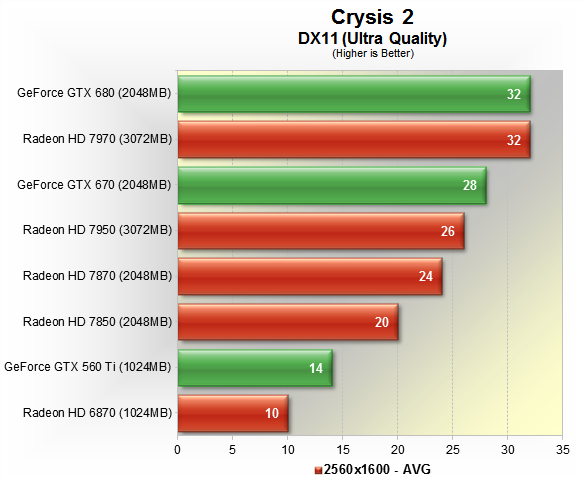 Performance: Radeon HD 7970
Value: Radeon HD 7970
Performance: Radeon HD 7970
Value: Radeon HD 7970
The HD 7970 matches the pricier GTX 680 in Crysis 2 at 2560x1600, securing both performance and value slots, since we don't consider anything slower than 30fps to be playable.
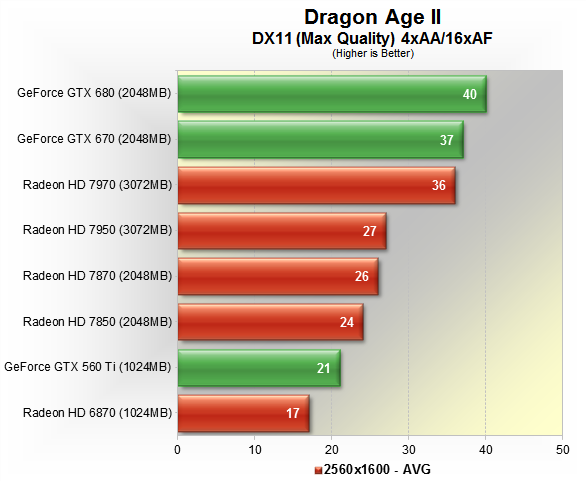 Performance: GeForce GTX 670
Value: GeForce GTX 670
Performance: GeForce GTX 670
Value: GeForce GTX 670
The GTX 670 presented itself as the best performance card for playing Dragon Age II at 2560x1600 with an average of 37fps, and since everything under the GTX 670 was either too slow or presented a weaker value proposition, it also occupies the second slot.
2560x1600 Performance, Part 2
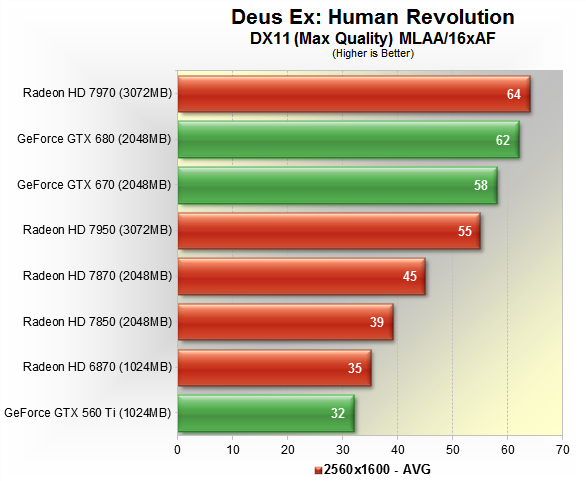 Performance: Radeon HD 7970
Value: Radeon HD 7950
Performance: Radeon HD 7970
Value: Radeon HD 7950
The HD 7970 performed exceptionally well in Deus Ex: Human Revolution at 2560x1600, averaging 64fps, while the HD 7950 was only slightly slower than the GeForce GTX 670 with 55fps, but much
faster than anything else.
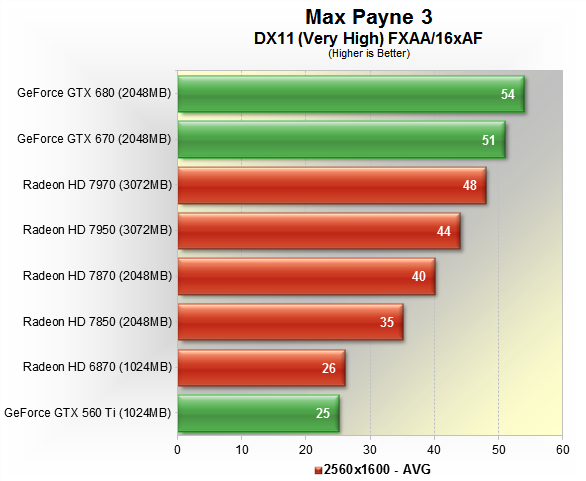 Performance: GeForce GTX 670
Value: GeForce GTX 670
Performance: GeForce GTX 670
Value: GeForce GTX 670
Those wanting to play Max Payne 3 at 2560x1600 will find the GTX 670 to be the best all-around pick, whether you're focused on
performance or savings.
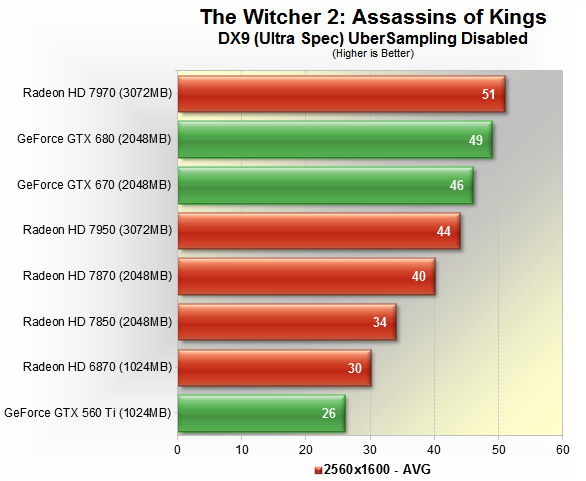 Performance: Radeon HD 7970
Value: Radeon HD 7970
Performance: Radeon HD 7970
Value: Radeon HD 7970
The HD 7970 performed very well in The Witcher 2 with an average of 51fps, and although the HD 7950 was technically a better value option when comparing
price versus performance, we felt that 44fps was less than desirable and opted for the HD 7970 for both picks.
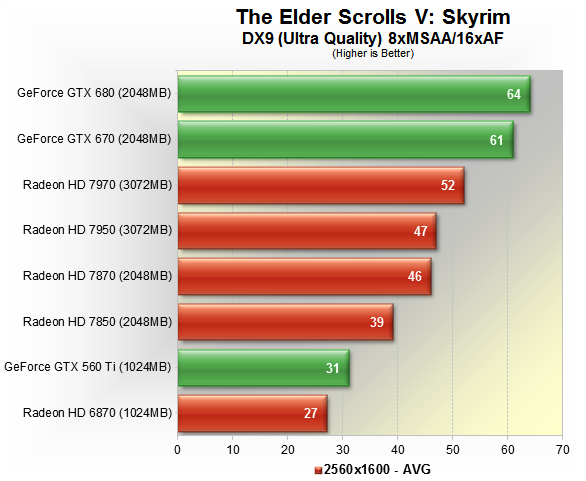 Performance: GeForce GTX 670
Value: GeForce GTX 670
Performance: GeForce GTX 670
Value: GeForce GTX 670
Skyrim was clearly won by the GTX 670 as it averaged 61fps, just a fraction slower than the GTX 680 and much faster than the HD 7970.
 Performance: GeForce GTX 670
Value: GeForce GTX 670
Performance: GeForce GTX 670
Value: GeForce GTX 670
As we found at 1920x1200, the GTX 670 is the winner when testing Alan Wake at 2560x1600.
Winners and Losers
Ever since we tested the GeForce GTX 670, we knew this had to be the best value high-end graphics card in the market. However, this impression was mostly based on 2560x1600
performance since the GPU could easily maneuver the workload. This time we are also looking at lower resolutions where other more affordable contenders can perform admirably (60fps or higher), so we were interested to see how it compared at 1920x1200.
We still feel the GTX 670 is the best performance option available at 1920x1200, but with an average of 71fps across the games tested, some might argue it's more than you need for the money. Therefore, staying true to our original parameters, the best value card for 60fps gameplay is the Radeon HD 7950.
Our
data tables below will help you digest how today's graphics cards stack up. These findings are based on maximum visual settings for each title and the numbers
will change drastically if you tweak visuals. By reducing or disabling certain features such as shadows, it is entirely possible to squeeze playable performance out of lesser cards at the tested resolutions. Given the endless possibilities, we're sticking with maximum settings for ease of making comparisons.
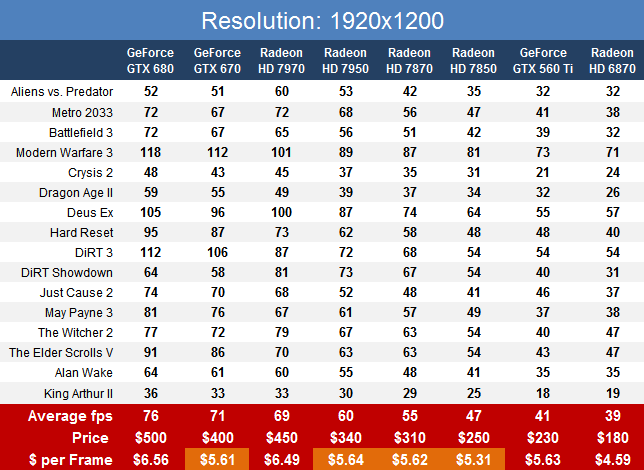
The GTX 670 is an incredible value for a high-end graphics card, costing $5.61 per frame with solid performance across the board. By comparison, you would pay $6.56 per frame with the GTX 680 or $6.49 per frame with the HD 7970. A
strong case could also be made for the HD 7950, which runs $5.64 per frame but costs about $60 less than the GTX 670 and delivers an average performance of 60fps.
Similarly, it'd also be possible to get away with the HD 7870 at this resolution as it offered the same cost per frame value as the GTX 670, albeit with an average frame rate of 55fps and a total cost of $310.
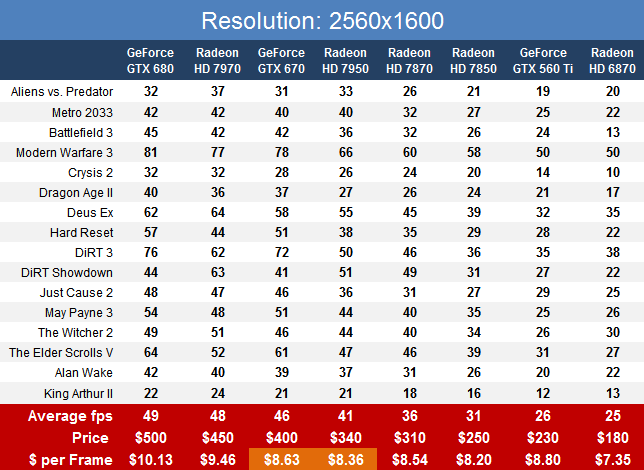
At 2560x1600, we picked the GTX 670 as both the best performance and value option, costing $8.63 per frame versus $10.13 for the GTX 680 and $9.46 for the HD 7970, while averaging only a few frames per second less.
The HD 7950 is technically a slightly better value than the GTX 670, but at extreme resolutions such as this, every frame counts and it's easy to justify a slight premium for Nvidia's card.
To recap, the GTX 670 is hands down the best value for gaming card currently available.by stephen walton



